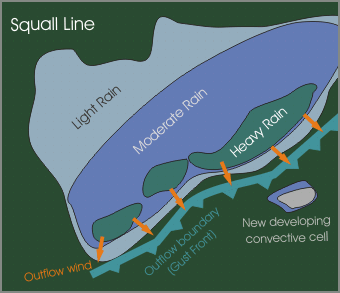| A squall line describes a linear system of thunderstorm convective cells with a continuous, well developed gust front at the leading edge.
Squall lines develop in subtropical potentially unstable warm air, typically in front of a cold front, dry line boundary or other
linear convergence structures. The thunderstorms first develop where the best combination of moisture, instability and lifting is to be found. The storm continues to evolve and new cells develop (commonly east and southwards). The squall line sustains itself by producing immanent vertical circulation processes due to outflow boundaries at the leading edge. At the rear, a large pool of cold air with continuous rain develops and causes a strong temperature gradient. Lifted by cold outflowing air, new convective cells can develop in front of the squall line. By merging with these cells the movement of the squall line can be accelerated and can differ from the main streaming direction. The squall line continues to propagate as long as instability and moisture remain present out ahead of the squall line. The lifespan of a squall line might be more than 12 hours in extreme cases. |
 Precipitation structure of a squall line |
References
- Jacobs, W.: Nutzen von Satellitendaten für Wetterüberwachung und -prognose. Lecture notes, March 2007.
- Manual of Synoptic Satellite Meteorology